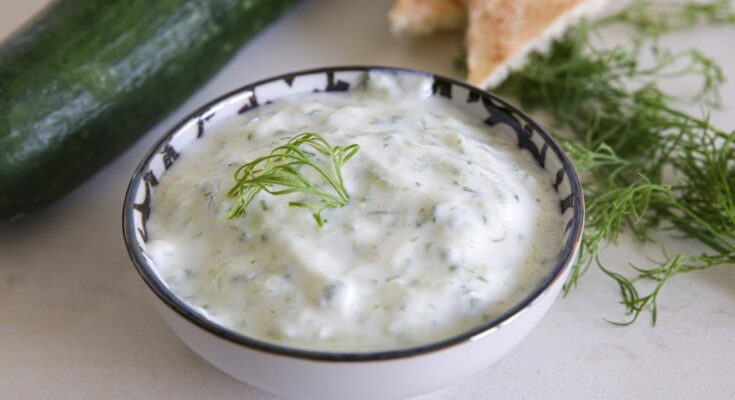Greek Tzatziki Sauce Recipe: Tzatziki is one of those sauces that, once you’ve tasted it, you’re hooked for life. It’s creamy, garlicky, tangy, and refreshing all at once. Originating from Greece, this yogurt-based dip is made primarily from Greek yogurt, cucumbers, garlic, olive oil, and a splash of lemon juice or vinegar. It’s often seasoned with fresh herbs like dill or mint. What makes tzatziki truly special is its simplicity—yet it brings such a dynamic burst of flavor to any dish it’s paired with.
Imagine biting into a warm piece of pita bread slathered with cold, creamy tzatziki. That contrast of textures and temperatures is divine. It’s not just a sauce—it’s an experience. And the best part? You can make it right at home with just a few ingredients you probably already have in your kitchen.
History and Origins of Tzatziki
Tzatziki has deep roots in the Mediterranean and Middle Eastern regions. While it’s now widely recognized as a Greek condiment, its origins are shared among several cultures. In Turkey, a similar sauce is called “cacık,” and in the Balkans, variations exist under different names. The essence remains consistent: yogurt, cucumber, and garlic.
The Greeks perfected the art of this sauce, often pairing it with grilled meats like souvlaki or gyros. It reflects the heart of Greek cuisine—simple, fresh ingredients prepared with care. Over the years, tzatziki has gained international fame, gracing the tables of fusion restaurants and health-conscious home kitchens alike.
Why You’ll Love This Recipe
Health Benefits of Tzatziki Sauce
Aside from its irresistible taste, tzatziki is also a health superstar. It’s low in calories, high in protein (thanks to Greek yogurt), and packed with probiotics that promote gut health. Cucumbers add hydration and a dose of vitamins K and C, while garlic brings anti-inflammatory properties. Olive oil adds healthy fats and antioxidants, making this dip not only delicious but also good for your body.
If you’re watching your weight or trying to eat clean, tzatziki is your go-to condiment. It’s an excellent replacement for heavy, creamy dips and dressings. Plus, it’s naturally gluten-free and can be made vegan by using dairy-free yogurt.
Flavor Profile and Texture
Tzatziki’s flavor is where it truly shines. It’s a delicate balance of tanginess from the yogurt and lemon, crunch from the cucumber, and sharpness from the garlic. Fresh dill (or mint) adds an herby brightness, while olive oil gives it a rich, smooth finish. The result? A sauce that’s light yet full of character.
In terms of texture, tzatziki is thick, creamy, and slightly chunky—thanks to the grated cucumber. It spreads beautifully over bread, clings lovingly to grilled meats, and dips perfectly with veggies. It’s versatile enough to be both the star of a dish or a complementary sidekick.
Ingredients Needed
Essential Ingredients
To create authentic Greek tzatziki, you only need a handful of ingredients. Here’s what you’ll need:
- Greek Yogurt (2 cups): The base. Choose full-fat for the creamiest texture.
- Cucumber (1 medium): Peeled, grated, and drained to remove excess water.
- Garlic (2-3 cloves): Minced or finely grated for maximum flavor.
- Olive Oil (2 tbsp): High-quality extra virgin for richness.
- Lemon Juice (1 tbsp): Freshly squeezed for that zesty tang.
- Salt (to taste): To enhance all the flavors.
- Fresh Dill or Mint (1-2 tbsp): Finely chopped for an herby kick.
These core ingredients form the backbone of any traditional tzatziki. You can find all of them in a typical grocery store, and they come together in minutes to create something spectacular.
Optional Add-Ons for Flavor
While the classic recipe is hard to beat, you can always customize your tzatziki to suit your taste. Here are a few optional add-ons:
- Red Wine Vinegar: For a slightly sharper tang compared to lemon juice.
- Cracked Black Pepper: Adds depth and a subtle kick.
- Chopped Chives or Parsley: For added freshness.
- Paprika or Sumac: Sprinkle on top for color and a hint of exotic flavor.
These extras can elevate your tzatziki from great to unforgettable. Play around with them to find your signature twist on the traditional recipe.
How to Make Authentic Greek Tzatziki Sauce
Step 1: Choosing the Right Yogurt
The foundation of any great tzatziki is the yogurt, and Greek yogurt is the absolute gold standard. It’s thicker and creamier than regular yogurt because it’s been strained to remove excess whey. This gives tzatziki its luxurious texture and concentrated flavor. Make sure to use plain, unsweetened Greek yogurt—preferably full-fat for the richest result.
Avoid flavored or sweetened yogurts; they’ll throw off the taste completely. If you’re vegan or dairy-free, go for a plant-based Greek-style yogurt made from coconut, almond, or soy milk. Just check the label to make sure it’s unsweetened and has a similar texture to dairy-based Greek yogurt.
Step 2: Preparing the Cucumber
Cucumber brings freshness and crunch to tzatziki, but it also contains a lot of water. If you don’t remove the moisture, your tzatziki can end up watery and bland.
Here’s how to prep it right:
- Peel the cucumber and cut off the ends.
- Grate it using the large holes of a box grater.
- Place the grated cucumber in a clean towel or cheesecloth.
- Squeeze out as much water as you can—seriously, get it dry!
This step is crucial. You’ll be surprised how much water comes out, and removing it ensures your sauce stays thick and creamy instead of runny.
Step 3: Mixing and Balancing Flavors
Once your cucumber is ready, it’s time to bring everything together. In a large bowl, combine the Greek yogurt, grated cucumber, minced garlic, olive oil, lemon juice, salt, and chopped dill.
Mix well until everything is fully combined. Then taste and adjust. Need more tang? Add a touch more lemon. Want more garlic punch? Throw in another clove. Tzatziki is all about balance, and a quick taste test can help you tweak it to perfection.
Once mixed, cover the bowl and refrigerate for at least 1 hour before serving. This resting time allows the flavors to meld and deepen, turning a good tzatziki into an amazing one.
Tips for the Perfect Tzatziki
Perfecting tzatziki isn’t just about following a recipe—it’s about understanding what each ingredient brings to the table and how to treat it. Here are some expert tips to elevate your homemade tzatziki from good to restaurant-quality.
1. Don’t skip the cucumber draining: This is arguably the most critical step. Cucumber is packed with water, and if you skip draining it, you’ll end up with a watery dip. Use a clean kitchen towel or cheesecloth and give it a solid squeeze. If your tzatziki ever turns out runny, this is likely the culprit.
2. Use full-fat Greek yogurt: Full-fat yogurt not only tastes better but also has a thicker, creamier consistency, which is essential for tzatziki. Low-fat or non-fat versions can be thinner and less satisfying.
3. Let it rest before serving: Once you’ve mixed all your ingredients, let the sauce sit in the fridge for at least an hour. This resting period allows the garlic to mellow out and the flavors to blend beautifully.
4. Adjust to taste: Tzatziki is highly customizable. Some like it extra garlicky, while others prefer a subtle herb note. Taste as you go, and don’t hesitate to tweak it.
5. Serve it cold: Tzatziki is best enjoyed chilled. The cool temperature enhances its refreshing qualities and contrasts beautifully with hot dishes like grilled meats or spicy foods.
These simple yet effective tips will ensure your tzatziki is always a hit, whether you’re serving it at a summer BBQ or alongside a weeknight dinner.
How to Serve Tzatziki Sauce
As a Dip
Tzatziki shines as a dip. It’s one of the most crowd-pleasing appetizers you can put on the table. Pair it with:
- Warm pita bread or pita chips
- Fresh veggie sticks like carrots, celery, bell peppers, or cucumber
- Crispy falafel
- Fried zucchini or eggplant slices
It’s creamy, zesty, and garlicky, making it the perfect companion to crunchy snacks. It’s also a fantastic alternative to calorie-heavy dips like ranch or cheese-based options. Want to impress guests at your next party? A tzatziki platter is the way to go.
With Grilled Meats
Tzatziki and grilled meats are a match made in culinary heaven. In Greek cuisine, it’s often served with lamb, chicken souvlaki, or pork gyros. The sauce balances the smoky, savory flavors of grilled meats with its tangy freshness.
Here are some delicious pairings:
- Chicken skewers
- Grilled lamb chops
- Beef kebabs
- Roast pork
Just dollop some on top or serve it on the side. You’ll instantly elevate any protein from average to exceptional.
In Sandwiches and Wraps
If you’ve never tried tzatziki in a sandwich or wrap, you’re seriously missing out. It acts as both a sauce and a spread, adding moisture and a huge boost of flavor. Replace mayo or mustard with tzatziki and you’ve got yourself a Mediterranean masterpiece.
Try adding it to:
- Chicken or lamb wraps
- Grilled veggie sandwiches
- Turkey pitas
- Beef burgers
The cooling yogurt sauce complements spicy or savory fillings and takes every bite to the next level.
Storing and Preserving Tzatziki
One of the many perks of tzatziki is that it stores well, making it perfect for meal prep or saving leftovers. Here’s how to keep it fresh:
Storage Tips:
- Store it in an airtight container in the fridge.
- It stays fresh for about 3–4 days.
- Stir it well before each use, as some separation may occur.
Freezing Tzatziki?
While technically you can freeze tzatziki, it’s not recommended. The yogurt can separate and become grainy when thawed. Plus, the cucumbers can turn mushy. It’s best to enjoy it fresh or make a smaller batch you can finish in a few days.
If you want to prep ahead, you can mix the yogurt, garlic, lemon juice, and oil in advance, then add the cucumber and herbs the day you plan to serve it.
Common Mistakes to Avoid
Even the simplest recipes can go sideways if you’re not careful. Here are some common tzatziki missteps and how to avoid them:
1. Using regular yogurt instead of Greek yogurt: Regular yogurt is too watery and can’t provide the thick, rich texture that makes tzatziki irresistible.
2. Skipping the cucumber squeeze: Don’t underestimate how watery cucumbers are. Always grate and drain them thoroughly.
3. Overloading on garlic: Garlic is potent. Too much of it can overpower the sauce. Start with a small amount and increase it gradually to find your ideal balance.
4. Not allowing it to chill: Tzatziki needs time to develop flavor. Serve it too soon, and it might taste flat. Letting it rest in the fridge brings everything together.
5. Ignoring the herbs: Dill or mint adds a fresh, vibrant note. Don’t leave them out—they’re essential to achieving that authentic Greek flavor.
Avoiding these mistakes ensures your tzatziki is as close to the Greek original as possible—if not better.
FAQs about Greek Tzatziki Sauce Recipe
1. Can I make tzatziki without Greek yogurt?
Yes, but it won’t be as thick or creamy. If you use regular yogurt, strain it through cheesecloth for a few hours to remove excess liquid.
2. What can I substitute for dill in tzatziki?
Fresh mint or parsley makes a great alternative. Each brings a different flavor, so feel free to experiment.
3. Is tzatziki vegan?
Not traditionally, but you can make a vegan version using plant-based Greek-style yogurt.
4. How long can tzatziki sit out at room temperature?
It should be refrigerated, but it can sit out safely for about 2 hours. After that, it’s best to store it back in the fridge.
5. Can I use dried herbs instead of fresh?
Yes, though fresh herbs provide a brighter flavor. If using dried dill, use less—about 1 teaspoon instead of 1 tablespoon.
Conclusion
Tzatziki isn’t just a dip—it’s a taste of the Mediterranean. With its creamy yogurt base, crisp cucumber, punchy garlic, and fresh herbs, it’s the kind of sauce that makes everything better. Whether you’re dipping, spreading, or drizzling, tzatziki delivers on both flavor and nutrition.
Making it at home is easy, fun, and incredibly rewarding. Plus, it’s highly customizable to suit your taste. Once you master this simple recipe, you’ll never want to buy store-bought again. Trust me—your tastebuds will thank you.



